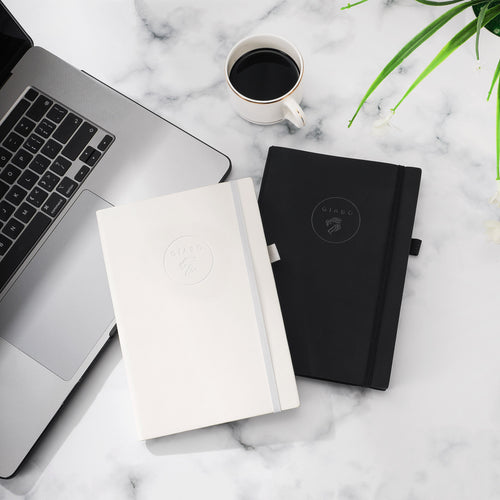
Softcover notebooks: Flexible, stylish and versatile for every occasion
Share
Notebooks are the ideal companion for people who enjoy writing, drawing, or capturing their thoughts. Among the many varieties, softcover notebooks are becoming increasingly popular—and for good reason. They are lightweight, flexible, and offer a wide range of designs. In this blog post, we'll explore the benefits, uses, and selection criteria of softcover notebooks . We'll also provide tips on how to find the perfect notebook for your needs.
What makes softcover notebooks so special?
Softcover notebooks, also known as "softback notebooks," are characterized by their flexible covers. Unlike hardcover notebooks, the covers are usually made of soft cardboard or other flexible materials. This design offers numerous advantages:
1. Lightweight and portable:
Softcover notebooks are significantly lighter than their hardcover counterparts. They fit easily into any bag and are perfect for traveling.
2. Flexibility:
Thanks to the soft cover, they can be easily bent and adjusted without losing quality. This is especially practical for people who write a lot on the go or use their notebook in small spaces.
3. Cost-friendly:
Softcover notebooks are often cheaper to produce, making them more attractively priced. However, there are also high-quality versions with elegant designs and special materials.
4. Versatile designs:
Whether minimalist, colorful, or personalized, softcover notebooks are available in countless variations. They're also easy to print, making them a popular promotional gift.
Areas of application of softcover notebooks
The uses for softcover notebooks are virtually endless. Here are some of the most popular ones:
1. Notes in everyday life
Softcover notebooks are ideal for quick notes. Whether it's to-do lists, shopping lists, or thoughts you want to jot down on the go, a softcover notebook is always handy.
2. Creative writing and journaling
For authors, bloggers, or journalers, softcover notebooks offer an ideal platform. Their lightweight design makes them the perfect choice for creative writing on the go.
3. Sketches and drawings
Many softcover notebooks feature blank pages, ideal for sketches, drawings, or mind maps. Artists and designers particularly appreciate the flexibility and portability of these books.
4. Study and work
Students and professionals use softcover notebooks for recording lecture notes, meeting minutes, or project ideas. Their simple elegance also makes them popular in professional settings.
5. Bullet Journaling
Bullet journaling is one of the most popular ways to use a notebook. Softcover notebooks offer the ideal basis for this creative planning and organization tool.
Advantages over hardcover notebooks
Softcover notebooks offer numerous advantages over hardcover alternatives. Here are the key differences:
Characteristic Softcover Hardcover
Weight Lighter and more portable Heavier and more robust
flexibility Bendable, adapts to the bag Rigid, can be unwieldy
Price Usually cheaper Often more expensive
Design options Easy to personalize More complex to produce
longevity Less robust More durable
While hardcover notebooks are ideal for the desk, softcover notebooks score points for their mobility and versatility.
What should you look for when buying a softcover notebook?
To find the right notebook, you should consider a few criteria:
1. Paper quality
Paper quality is crucial, especially if you write with different pens. Make sure it has a grammage of at least 80 g/m² to avoid ink bleed-through.
2. Ruling
Depending on the intended use, you should choose blank, lined, or squared pages:
• Blank: Ideal for drawings and creative ideas.
• Lined: Perfect for notes and texts.
• Squared: Suitable for tables, diagrams or mathematical calculations.
3. Size
Consider how you want to use your notebook. Popular formats include:
• A6 (small): Practical for on the go.
• A5 (medium): The most popular size, perfect for everyday and work use.
• A4 (large): For extensive notes and projects.
4. Design and cover material
The cover should not only be visually appealing but also fit your needs. Many softcover notebooks are made of coated cardboard that is water-resistant.
5. Sustainability
More and more manufacturers are offering eco-friendly notebooks made from recycled paper. This is a great way to reduce your carbon footprint.
Softcover notebooks as promotional gifts
Another highlight of softcover notebooks is their suitability as a personalized promotional item . Thanks to the flexible design options, you can have your company logo, a slogan, or a creative design printed on the cover. Notebooks are practical everyday items that customers or employees use frequently—this ensures long-term brand presence.
Personalized softcover notebooks are particularly popular with:
• Companies for marketing purposes.
• Events such as trade fairs or conferences.
• Schools, universities and clubs.
Care and storage of softcover notebooks
To ensure your softcover notebook lasts as long as possible, you should protect it from extreme stress:
• Use a protective case to protect corners and the cover from wear and tear.
• Store the notebook in a dry place to avoid moisture damage.
• Avoid overloading your notebook with extra sheets or documents, as this could damage the cover.
Conclusion: Softcover notebooks – your flexible everyday companion
Softcover notebooks are a practical and stylish companion for anyone who enjoys writing or creative work. They score points for their lightweight design, versatility, and wide range of designs. Whether you're taking quick notes, keeping a journal, or capturing your artistic ideas, a softcover notebook is always the right choice.
If you want to make a personal or business statement, you can also use custom designs and turn your softcover notebook into a unique promotional item.
Now it's up to you: Which softcover notebook will accompany your next project?
